What is alliteration? Alliteration is a type of writing, put into three different types, general alliteration, unvoiced alliteration, and symmetrical alliteration. Learn all about alliteration and it’s three forms in this complete guide.
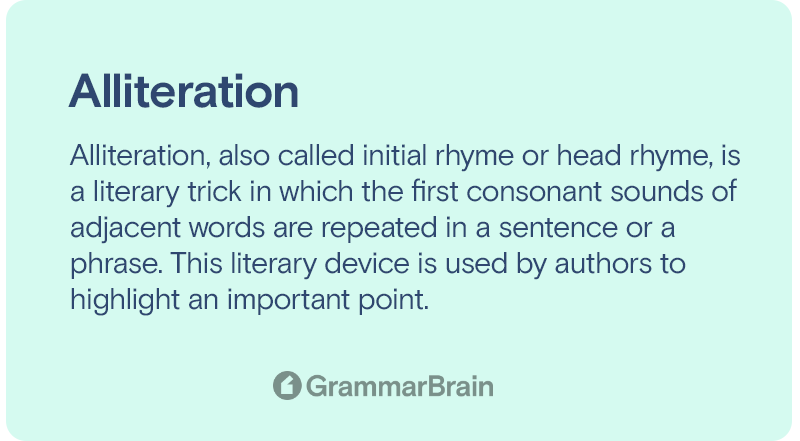
What is alliteration?
Alliteration, also called initial rhyme or head rhyme, is a literary trick in which the first consonant sounds of adjacent words are repeated in a sentence or a phrase. This literary device is used by authors to highlight an important point. Alliteration is created by repeated sounds, not the letter. This is commonly used in poetry to create a rhyming effect.
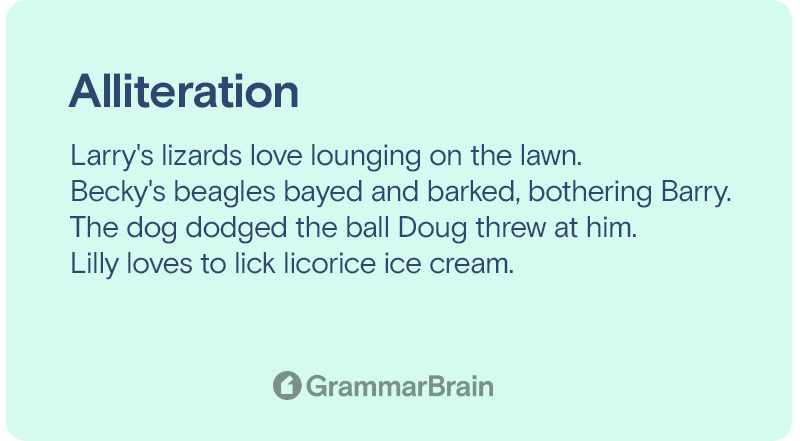
Examples:
- Larry’s lizards love lounging on the lawn.
- Becky’s beagles bayed and barked, bothering Barry.
- The dog dodged the ball Doug threw at him.
- Lilly loves to lick licorice ice cream.
- Maria married a man from Missouri.
- Ronny gave a riveting recitation at the end.
- Princess Priscilla picked her purple peanuts.
- Steve stole the stew from the stove.
- Don’t put the putty in the pitcher.
- The wicked witch wove the wicker basket.
Difference between alliteration, consonance, and assonance
Alliteration can often be confused with consonance or assonance. Consonance and assonance are figures of speech similar to alliteration because they also rely on similar sounds. But these two figures of speech are slightly different from alliteration.
Assonance
Assonance is the repetition of a vowel sound. The repetitive vowel sounds can be anywhere in words, but the words have to be in close proximity to each other. The title of this article might appear as an alliteration, but since the repetition relies on vowel sounds, not consonant sounds, it will be an example of assonance.
Examples of Assonance
Consonance
Consonance is when the consonant sound is repeated in two or more nearby words, but it is not necessarily at the start. Thus, alliteration is a type of consonance. Consonance involves repeated consonant sounds present anywhere in two or more words that are near each other. Below are some examples of non-alliteration consonance:
Consonance example
- Mike likes his new bike.
- A bond that transcends the beyond.
- Norm the worm got lost in the storm.
- Going against the grain.
Alliteration: The different types
The three different types of alliteration include:
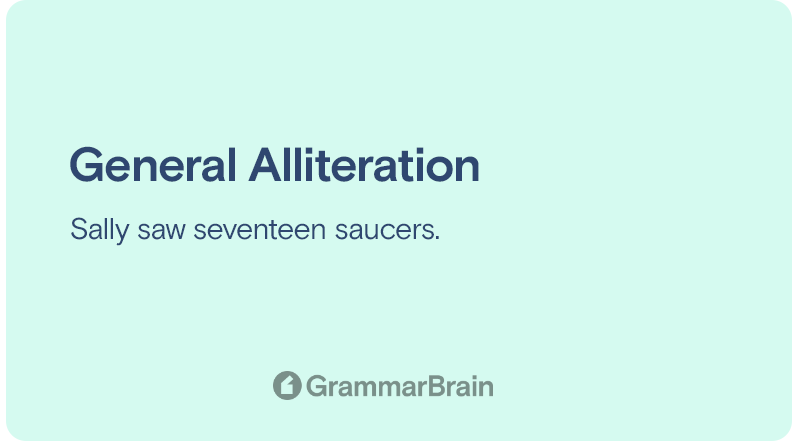
General alliteration
This is one of the most widely used forms of alliteration. It can be easily used and understood. In this form of alliteration, the beginning syllable or sound is repeated in a sentence or phrase.
Example:
Sally saw seventeen saucers.
In this example, alliteration is created due to the sound “s” being used repeatedly.
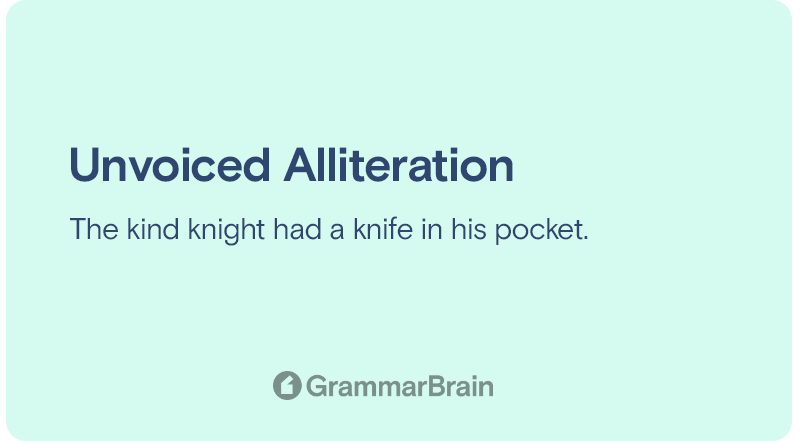
Unvoiced alliteration
This kind of alliteration is only noticed when looking at the written text and is often missed when an individual reads the text aloud. This happens because the repeating consonant sound may be silent in one or more words in the sentence.
Example:
The kind knight had a knife in his pocket.
In this sentence, the “k” sound is repeated, but the sound is silent in the words “knight” and “knife.” This makes it an unvoiced alliteration.
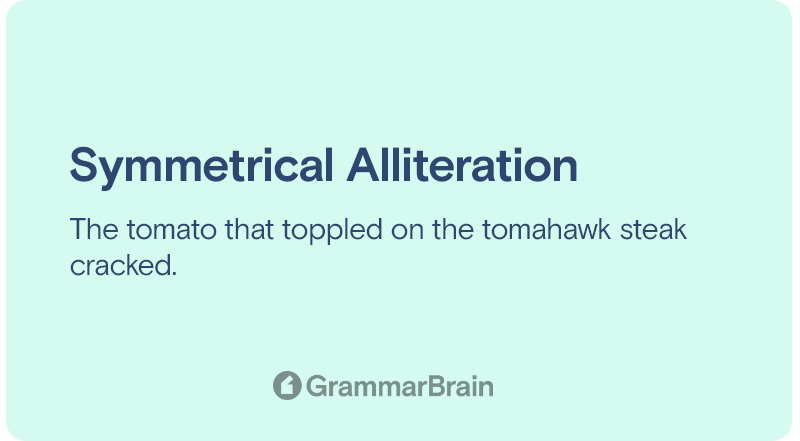
Symmetrical alliteration
This kind of alliteration is enjoyable to read, especially in poetry. This alliteration occurs when a phrase’s beginning and ending sounds are mirrored. It creates a sense of harmony and balance and, in some cases, produces a dramatic effect. Symmetrical alliteration contains chiasmus (a reversal of grammatical constructions in consecutive clauses or phrases) or parallelism.
Example:
The tomato that toppled on the tomahawk steak cracked.
In this sentence, the sounds “t” and “th” are repeated, but they alternate, giving a harmonic effect.
Examples of alliteration in different forms of writing
Alliteration can be used in different forms of literature like prose, poetry, songs, or even in names or everyday speech. Some examples include:
In poetry
Alliteration is frequently used in poetry to achieve the desired rhythm and melodic qualities that enhance the poem’s overall flow. This enhances the beauty of the poem, especially when read aloud.
Example:
Mary Angelou’s “The Caged Bird” has several alliterative phrases, like:
“The free bird thinks of another breeze
And the trade winds soft through the sighing trees”
Similarly, “The Raven” by Edgar Allan Poe is filled with alliteration. Example: “Doubting, dreaming dreams no mortal ever dared to dream before.”
In prose
Though not really common, alliteration can be used in prose just as effectively as it can in poetry. Authors can give their writing a poetic touch by using alliteration. Famous authors like William Shakespeare, Ernest Hemingway, F. Scott Fitzgerald, and James Joyce have used alliteration in their works.
Example:
The sentences “Being tasted, slays all senses with the heart” and “And flecked darkness like a drunkard reels” in Shakespeare’s “Romeo and Juliet” are examples of alliteration in prose. In the first sentence, the sound “s” is repeated, and in the second sentence, the sound “d” is repeated.
In common words or phrases
Alliteration is very frequently used in everyday language. Alliteration is used in a lot of well-known quotes, sayings, and phrases. Some common phrases include:
- last laugh
- money matters
- right as rain
- picture perfect
- ride roughshod
- nervous nelly
Alliteration is also used in some tongue twisters.
Examples:
- She sells seashells by the seashore.
- A peck of pickled peppers Peter Piper picked.
In company or brand names
Alliteration is frequently used by businesses to make their brand names more memorable. Several famous brands and companies have names that have alliteration in them. Examples include:
- Best Buy
- Krispy Kreme
- Lulu Lemon
- Dunkin’ Donuts
- Coca-Cola
- PayPal
- Backstreet Boys
In popular names
There are many popular fictional characters, both in literature and movies, and real celebrities, who have alliteration in their names. Some examples include:
- Sansa Stark
- Mickey Mouse
- Pete Parker
- Bruce Banner
- Marilyn Monroe
- Kim Kardashian
- Luna Lovegood
- Spongebob Squarepants
- Willy Wonka
Using alliterative names for characters in literature makes their names easier to remember.
Exercise on alliteration
From the sentences given below, identify the alliterative phrases or words and the type of alliteration.
- Sally wanted to buy bread, but she bought some cookies.
- Adam caught a cat playing catch with Plutus.
- The killer killed the knight with a knife.
- The gnome gobbled up the ginger root.
- Donald Duck tried to drive through the doorway.
- The dentist took the diving tool to the corner shop.
- Lola gave her lover a loving look.
- The kid knew that his knickers were knotted.
- Quincy quilted the quilt quickly.
- Arya alerted the armory about the alleged fight.
How to help kids understand alliteration
The best way to explain alliteration to kids is through examples.
Figures of speech are best understood through the use of real-life examples. The concept will be easily understood by giving them examples and helping them come up with their own alliterative words.
Another great way to explain alliteration is through exercises such as making them find alliteration in a poem or a text (use the exercise/quiz above).
An important part to focus on is to explain the differences between alliteration, assonance clearly, and consonance, as these can be easily confused with one another.
FAQs
What is the difference between consonance, assonance, and alliteration?
Alliteration can be considered a type of consonance. In consonance, a consonant sound is repeated, and this sound can be at the beginning, end, or middle of the sentence. The focus is mainly on the repeated sound rather than on its position. But in alliteration, the repetitive sound is almost always at the start of the word.
Example of consonance:
- Barbara reached the roof carrying Ron’s papers.
- Ronnie rowed the boat in the river through the storm.
- Norah numbly nodded at the numbers.
- Lick the liquid off the liquor pot.
- Mike likes to hike every morning.
In assonance, an identical or similar vowel sound is repeated, and this sound can be at the beginning, end, or middle of the sentence.
Example of assonance:
- Lola dropped the box on the toy boat.
- Noah nodded off on the couch.
- Bree fell asleep near the pear tree.
- The black cat ate a snack.
- Mike eats the sweet treats.
What are the effects of using alliteration?
Alliteration can be employed for creating a literary effect in prose, poetry, songs, and other forms of literature. Some common effects of using alliteration include:
- It can be used to draw the reader’s focus to a specific sentence or paragraph.
- It can create a rhythm to the prose or poetry when read out loud.
- It can help make certain phrases or words catchy and memorable.
- It can create different connotations.
How can we identify alliteration?
Alliteration can be identified by sounding out a sentence and by sounding out a sentence and searching for terms with similar initial consonant sounds. The first letter of an alliterative word need not be the same; only the first sound must be the same.
Can alliteration start with a vowel?
How do I make alliteration?
It is relatively simple to make an alliteration. Just take two words that start with the same consonant sound and put them right beside or in close proximity to each other in a sentence.
Can a name be alliteration?
Yes, a name can also be an alliteration—for example, Charlie Chaplin, Peter Pan, etc.
Sources:
- Merriam Webster – alliteration – Definition
- Wikipedia – Alliteration
- Grammarly – All About Alliteration
- StudySmarter – Alliteration
Inside this article
Fact checked:
Content is rigorously reviewed by a team of qualified and experienced fact checkers. Fact checkers review articles for factual accuracy, relevance, and timeliness. Learn more.
Core lessons
Glossary
- Abstract Noun
- Accusative Case
- Anecdote
- Antonym
- Active Sentence
- Adverb
- Adjective
- Allegory
- Alliteration
- Adjective Clause
- Adjective Phrase
- Ampersand
- Anastrophe
- Adverbial Clause
- Appositive Phrase
- Clause
- Compound Adjective
- Complex Sentence
- Compound Words
- Compound Predicate
- Common Noun
- Comparative Adjective
- Comparative and Superlative
- Compound Noun
- Compound Subject
- Compound Sentence
- Copular Verb
- Collective Noun
- Colloquialism
- Conciseness
- Consonance
- Conditional
- Concrete Noun
- Conjunction
- Conjugation
- Conditional Sentence
- Comma Splice
- Correlative Conjunction
- Coordinating Conjunction
- Coordinate Adjective
- Cumulative Adjective
- Dative Case
- Determiner
- Declarative Sentence
- Declarative Statement
- Direct Object Pronoun
- Direct Object
- Diction
- Diphthong
- Dangling Modifier
- Demonstrative Pronoun
- Demonstrative Adjective
- Direct Characterization
- Definite Article
- Doublespeak
- False Dilemma Fallacy
- Future Perfect Progressive
- Future Simple
- Future Perfect Continuous
- Future Perfect
- First Conditional
- Irregular Adjective
- Irregular Verb
- Imperative Sentence
- Indefinite Article
- Intransitive Verb
- Introductory Phrase
- Indefinite Pronoun
- Indirect Characterization
- Interrogative Sentence
- Intensive Pronoun
- Inanimate Object
- Indefinite Tense
- Infinitive Phrase
- Interjection
- Intensifier
- Infinitive
- Indicative Mood
- Participle
- Parallelism
- Prepositional Phrase
- Past Simple Tense
- Past Continuous Tense
- Past Perfect Tense
- Past Progressive Tense
- Present Simple Tense
- Present Perfect Tense
- Personal Pronoun
- Personification
- Persuasive Writing
- Parallel Structure
- Phrasal Verb
- Predicate Adjective
- Predicate Nominative
- Phonetic Language
- Plural Noun
- Punctuation
- Punctuation Marks
- Preposition
- Preposition of Place
- Parts of Speech
- Possessive Adjective
- Possessive Determiner
- Possessive Case
- Possessive Noun
- Proper Adjective
- Proper Noun
- Present Participle
- Prefix
- Predicate



